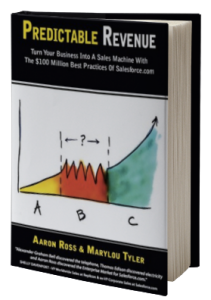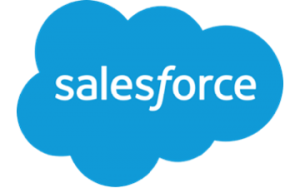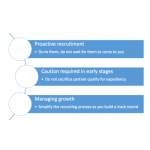Designing Predictable Revenue Generation Models
 The book Predictable Revenue (Turn Your Business Into A Sales Machine With $100 Million Best Practices of salesforce.com) by Aaron Ross and Marylou Tyler is from 2011, but it is still a book worth reading. In these days of the booming “Inbound” movement and the increasing volume of “social selling” hype, reading the book is now probably more important than when it came out five years ago.
The book Predictable Revenue (Turn Your Business Into A Sales Machine With $100 Million Best Practices of salesforce.com) by Aaron Ross and Marylou Tyler is from 2011, but it is still a book worth reading. In these days of the booming “Inbound” movement and the increasing volume of “social selling” hype, reading the book is now probably more important than when it came out five years ago.
The main focus of the book explains how to build an outbound sales function that can produce predictable revenue and therefore scale and then take you to market leadership. Why would you do that if you can outperform the market and your competitors through your inbound strategy? Well, the issue is that only very few companies actually outperform their competitors through their inbound activities. Proactively reaching out to your potential customers is still required for the vast majority of B2B companies if they have any ambition of growing their companies.
The primary reason why the inbound movement has gained momentum is that most people hate making cold sales calls and the secondary reason is that most people also hate receiving cold sales calls. A growth strategy based on genuine outbound cold calls is hard to make predictable and therefore also almost impossible to scale.
Salesforce.com had struggled with building a direct and outbound sales force for two years when Aaron was assigned to re-engineer the process in 2003. Based on his experience making it work for salesforce.com he wrote the book “Predictable Revenue.” You should certainly read the book to get all the details, but here are my main takeaways from the book.
Marketing and sales are business processes
 This headline may be stating the obvious, but for many executives in the information technology industry marketing and sales are still treated as some kind of magic, wizardry and voodoo. Executives are constantly looking for the quick fix that miraculously will make their marketing activities reach the eyes of their potential customers and make them rush to the phone or the BUY NOW button to place an order.
This headline may be stating the obvious, but for many executives in the information technology industry marketing and sales are still treated as some kind of magic, wizardry and voodoo. Executives are constantly looking for the quick fix that miraculously will make their marketing activities reach the eyes of their potential customers and make them rush to the phone or the BUY NOW button to place an order.
That didn’t happen for salesforce.com in the early days. Instead of throwing new people at the same failing process Aaron took a different approach to the challenge. He viewed the marketing and sales processes as genuine business processes that first needed to be understood, then re-engineered, then implemented, then monitored, then measured and then re-engineered again, repeating the iteration circle until the outcome of the processes became predictable.
Takeaway: Improving marketing and sales processes is a business process re-engineering exercise.
Unsolicited cold calls are dead
Any outbound marketing and sales function must call the potential customers at some stage. Relying on the customers to figure out that they need your product and that they will grab the phone and call you doesn’t always create enough leads (to phrase it as positively as I can). Randomly calling people in your target group to start a sales process is just not very productive for the vast majority of companies. Aaron found ways to make such calls less cold.
Takeaway: Cold calling may be unproductive, but outbound calling is still required. There are ways to melt the ice first.
Division of labor is required
 I see this mistake made again and again. Executives assign individual sales people to run the entire marketing and sales processes. Sales people are expected to find their own leads, call them, nurture them, activate them, develop them, close them and manage them.
I see this mistake made again and again. Executives assign individual sales people to run the entire marketing and sales processes. Sales people are expected to find their own leads, call them, nurture them, activate them, develop them, close them and manage them.
Before 2003, salesforce.com did the same and it didn’t work.
Aaron now introduces the division of labour, which eventually leads to the creation of the following roles:
- Marketing is still responsible for mass market communication and generic campaigns.
- Inbound sales development takes care of unsolicited inbound inquiries.
- Outbound sales development works on a well defined list of potential customers with carefully crafted value propositions. They reach out to the target customers using a standardized process and only place a call when some well defined qualification criteria are met.
- Sales takes care of highly qualified leads passed from the outbound as well as the inbound sales development teams.
- Account managers take care of managing and up and cross selling to existing customers.
This division of labour and specialization became very productive at salesforce.com and after a series of readjustments of the definition of the “ideal customer profile” and the “customer value proposition” the outcome also became predictable and therefore scalable. Aaron now knew what results he could expect from adding resources to his business processes and asking management for additional resources became much easier. Sales was no longer wizardry or magic, but process that could be monitored and managed.
Takeaway: Assigning individuals to run the entire prospecting and sales process is hard to make productive and will not scale. Introduce division of labor and specialization.
People still makes the difference
Hiring wizards and magicians to turn dust into gold has always been a very difficult endeavor and most executives are often disappointed with the quality of magicians and wizards they hire. Then they dismiss them and hire a promising new bunch.
Introducing the division of labour and specialization makes the hiring much easier. The pool of talent is much larger and mastering the various roles can be taught and learned. It doesn’t mean that you can hire anybody to do these jobs, but you certainly have a larger pool to source from and you can work in a much more structured way, coaching the people.
Takeaway: The pool of resources becomes much larger when you introduce division of labor and specialization.
Things take time
It took Aaron a full year to prove that the approach worked. KPIs looked good after just four months, but he had to demonstrate that they would actually convert into paying customers before he could claim the program was successful.
Takeaway: Be patient. Keep testing and refining your approach before you conclude if it works or not.
Software required
 Introducing the division of labour and the other approaches used to warm leads before engaging on an individual basis cannot be done without software. salesforce.com took their own medicine and ensured that all processes and communication was carefully documented in the software platform. In marketing and sales this requires a substantial amount of discipline by all the stakeholders involved and without the top executives leading the way as role models that will not happen. Aaron claims, and I agree with him, that you cannot run a predictable and scalable marketing and sales operation without software and you need people that are committed to using it to its’ full potential. He even recommends pressing the red button and stopping everything if a review session is being confused by missing documentation. What’s not in the software system doesn’t exist.
Introducing the division of labour and the other approaches used to warm leads before engaging on an individual basis cannot be done without software. salesforce.com took their own medicine and ensured that all processes and communication was carefully documented in the software platform. In marketing and sales this requires a substantial amount of discipline by all the stakeholders involved and without the top executives leading the way as role models that will not happen. Aaron claims, and I agree with him, that you cannot run a predictable and scalable marketing and sales operation without software and you need people that are committed to using it to its’ full potential. He even recommends pressing the red button and stopping everything if a review session is being confused by missing documentation. What’s not in the software system doesn’t exist.
Takeaway: Use software to run your marketing and sales processes and have the top executives lead the way as roles models.
International growth
Predictable Revenue is quite comprehensive and can actually be used to test the exercise in any company, but there is an area that has been left out and that I believe is important to many companies at least in the geography where I operate: international expansion.
Most US books are about doing business in the US and this book is no different. That doesn’t mean that there is not a lot of value for Swedish, German, Italian etc. companies to read the book, it just means that there is not a single line about how to implement the principles across borders and in different cultures.
Highly recommended
 I can highly recommend reading Predictable Revenue. It may not be a literary masterpiece, but it is easy to read and it is packed with practical and very valuable advice.
I can highly recommend reading Predictable Revenue. It may not be a literary masterpiece, but it is easy to read and it is packed with practical and very valuable advice.
Four stars out of five from me. A chapter on international application would have given it the fifth star.








